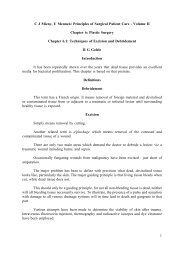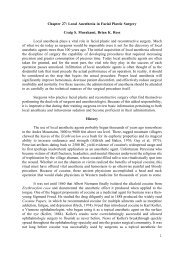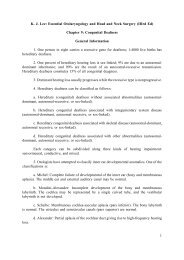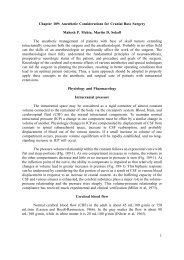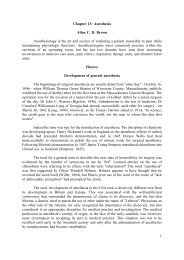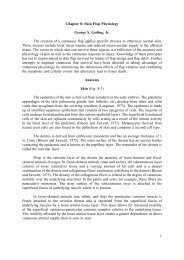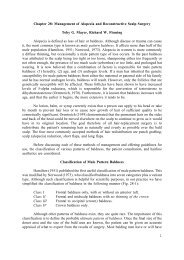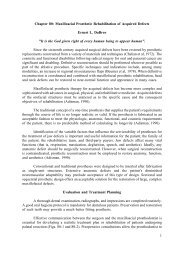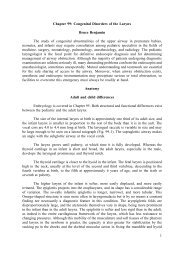1 C J Mieny, U Mennen: Principles of Surgical Patient Care - Volume ...
1 C J Mieny, U Mennen: Principles of Surgical Patient Care - Volume ...
1 C J Mieny, U Mennen: Principles of Surgical Patient Care - Volume ...
- No tags were found...
Create successful ePaper yourself
Turn your PDF publications into a flip-book with our unique Google optimized e-Paper software.
infraorbital nerve in the infraorbital canal. An isolated unilateral Le Fort II fracture with amidpalatal fracture may be seen occasionally.Arcus FractureThe arcus or temporal process <strong>of</strong> the zygomatic bone and zygomatic process <strong>of</strong> thetemporal bone may be involved without any fractures <strong>of</strong> the zygomatic bone itself. A fracture<strong>of</strong> the arcus, on its own, usually presents with three fractures <strong>of</strong> this bony arch and thefracture fragments will be displaced medially. A single fracture <strong>of</strong> the arcus is normally foundwhen it occurs in conjunction with a zygomatic bone <strong>of</strong> a Le Fort III fracture.Lateral or Supero-Lateral Orbital Margin FractureA direct blow against the supero-lateral margin <strong>of</strong> the orbita may result in thisrelatively rare type <strong>of</strong> fracture. The fracture may be simple or it may be comminuted.Inferior Orbital Blow-Out FractureAs in the case <strong>of</strong> a "medial orbital blow-out fracture" the inferior orbital blow-outfracture occurs after a direct blunt trauma force has been exerted against the globe. This isthe most common type <strong>of</strong> orbital blow-out fracture.The fracture involves the orbital floor or the ro<strong>of</strong> <strong>of</strong> the maxillay sinus without anyinvolvement <strong>of</strong> the infra-orbital margin.The orbital floor may be cracked or comminuted, with or without displacement <strong>of</strong>parts <strong>of</strong> the orbital contents into the maxillay sinus.Zygomatic Bone FractureThe zygomatic bone may be described as having "three feet" namely the frontalprocess, the temporal process and the malar process (adjacent to the maxillo-zygomaticsuture), hence the name "tripod", trimalar or malar-maxillary fracture. The zygomatic bonefracture is also known as the "quadrimalar" fracture, because it is possible to diagnose fourfractures surrounding the malar bone. These four fractures involve the following areas: thefronto-zygomatic suture, the temporo-zygomatic suture, the inferior region <strong>of</strong> the malarprocess, and the infra-orbital margin.A zygomatic bone fracture may be undisplaced, or displaced in the medial (mostly)direction. However, it may be displaced laterally, or rotationally in the antero-posterior orsupero-inferior dimension. The zygomatic bone may also be comminuted with bone fragmentsdislodged into the maxillary sinus. As in the Le Fort I and Le Fort II fractures, the maxillarysinus is always involved.Le Fort III FractureThis type <strong>of</strong> fracture is also known as a supra-zygomatic or a transverse facial fracture.The fracture line is in the region <strong>of</strong> the nasion and is usually one centimetre more superior24



